Are you unable to keep up with your sourdough starter’s feeding schedule? Don’t fret as this happens to many new bakers. Understanding the neediness for a sourdough starter may take some time and patience. That being said, there are some common factors that may cause your sourdough starter to become inactive, or unresponsive to its feeding. Fortunately, this article is brimming with answers to the problem. So let’s take a look at how to revive an inactive sourdough starter!
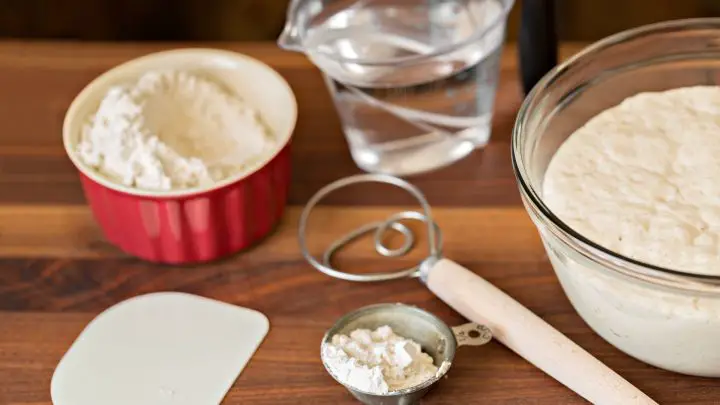
Table of Contents
- What is a Sourdough Starter?
- How to Revive an Inactive Sourdough Starter?
- Why is My Sourdough Starter Moldy?
- How to Rescue a Moldy Sourdough Starter?
- How to Tell if Sourdough Starter Has Spoiled?
- What if I Can’t Feed My Starter?
- How to Keep Your Starter Happy
- Delicious Sourdough Recipes
- How to Revive Sourdough Starter
- How to Revive an Inactive Sourdough Starter – FAQs
What is a Sourdough Starter?
A sourdough starter is a culture of natural yeasts and bacteria used to leaven bread and provide unique tangy flavors. The sourdough starter requires the simplest of ingredients to create a live culture. Both flour and water are added to a glass jar and left out to ferment.
Most sourdough starters contain lactic acid bacteria, which provide the sourdough loaves with a subtle yet unmissable sour flavor.
How to Revive an Inactive Sourdough Starter?
Reviving an inactive sourdough starter is very similar to feeding a normal sourdough starter, except for a couple of differences. The best way to go about this is to be patient and not feed it too often. The starter requires more time to gradually rebuild the population of starved microbes inside of it. It may take several feedings before it is fully activated.
While it may take more than one feeding to revive a sourdough starter, it’s important to understand that feeding your starter several times in one day won’t wake it up. In fact, this can cause the opposite effect, and send the microbes to sleep forever.
Process
- If your starter has been stored in the refrigerator, remove it and allow it to warm to room temperature for several hours before proceeding.
- If your starter developed some hooch a week or two after feeding, then you can stir it back in, or simply pour it off. Keeping the hooch is one way to make your starter taste sourer, I mean if that’s what you want! However, it’s best to remove the hooch when reviving an old starter that hasn’t been fed for a month or longer.
- Give your starter a fresh, clean container. Transfer a portion of your old starter into another container before feeding it. If you don’t have another container to use, then temporarily transfer the remaining starter into a clean bowl, while you wash its container.
- You only need 1/2 a cup of sourdough starter, so you can either discard or store the remainder in a different container to keep for future recipes.
- In a fresh container, combine equal parts flour and water with an equal amount of sourdough starter. Stir well, and keep track of your starter’s growth.
- Place the starter in a warm spot. A sourdough starter is at its best when it is placed in a warm place (70-75F).
- A well-maintained sourdough starter will begin to rise within a couple of hours of feeding it. However, an old and neglected sourdough starter can take 24 hours or longer. You should wait at least 24 hours before feeding it again.
- Next, stir the starter and remove all but half a cup. Now repeat step 5 and put the starter back in a warm place. You don’t have to wait another 24 hours to feed it again, as the starter will show you when it’s ready.
- Feed your starter once again if necessary, especially if you’re planning to bake sourdough bread. Once the old starter has been reactivated it will double in size.
Tips to Help With a Weak Sourdough Starter
Is your sourdough starter not rising? Perhaps these tips will help.
- To revive an old sourdough starter, try feeding it with half bread flour, or all-purpose flour, and half whole wheat flour or rye flour. Rye flour tends to make sourdough starters pretty bubbly.
- Your starter could be cold. Use a thermometer to monitor the temperature of the starter. If it’s below 65F, then find a warmer spot. You could opt to use a small heat mat or heating pad nearby (but not directly on the starter). Another option is to turn on your oven light and place the starter near the light. Make sure the oven is turned off.
- A runny or thin sourdough starter will neither rise nor bubble well. Alternatively, it may rise but fall back quickly. Aim for a starter consistency that is similar to a very thick pancake batter. If you were to tip your starter container sideways, the starter should slowly move, rather than pour right out of the container. So if your starter seems exceptionally runny, or stiff, try adding more flour, about a couple of tablespoons at a time.
Why is My Sourdough Starter Moldy?
The appearance of mold on sourdough starters is pretty common with young or brand-new starters. This is because the new colony of bacteria and yeast isn’t established enough to keep the mold away. This is why your starter may grow mold if left unfed for a long time.
However, it is also possible for an old or established sourdough starter to mold. Mainly due to contaminated utensils coming into contact with your sourdough starter. One of the ways to avoid this is to place your starter in a sealed container, and ensure that any type of utensil used is thoroughly cleaned.
Why Is There Mold on My Sourdough Starter?
Mold is inescapable, especially if you’re nursing a live culture like a sourdough starter. And while the sourdough starter is brimming with beneficial bacteria and microbes that fight off impurities like mold, a young sourdough starter won’t be able to do this, simply because the microbes aren’t established enough to fight this battle!
- One of the major reasons for mold appearing on your starter is due to the type of flour you’re using. Sometimes the flour we choose might not work for our starter, meaning that we may have to start over if things don’t improve!
- As mentioned before, irregular feedings are a common reason for mold growth.
- A neglected sourdough starter is a perfect place for mold to grow.
- The starter jar is contaminated
Can You Use a Moldy Sourdough Starter?
When it comes to mold growing on your sourdough starter, sadly there is no saving it. Though a little mold growth isn’t a cause for concern, and can simply be scooped up and thrown away. Then top up your starter with fresh flour and water to bring it back to its original state.
However, in the event of mold growing all over the starter and container, then you must throw it all away!

How to Rescue a Moldy Sourdough Starter?
When you’re looking to revive a weak or old sourdough starter, you’ll need to accomplish a few important goals. And these are:
- Remove the layer of mold from the starter.
- Thoroughly clean your sourdough jar.
- Top up your sourdough starter with fresh flour and water.
De-Mold
Spoon out the moldy later, ensuring that you’ve gotten rid of most of it. Refresh your starter with fresh flour and water, then the microbes should take over and destroy any remaining mold.
Transfer
Pour out the remaining starter from the jar into a clean measuring cup or bowl. Try not to scrape the sides of that jar when you do this, as you wouldn’t want to add fragments of mold to the starter. Although you can scrape the bottom of the container if you wish.
Wash
Thoroughly wash the sourdough starter container, and remove any bits of mold using hot soapy water. Remember to wash off any dried bits of starter that cling to the sides of the container.
Feed
You must feed the starter with fresh flour and water. For 1/2 a cup of starter, add 1 cup of flour and water to achieve the desired consistency. You can leave the starter in the bowl you’ve placed it in, or put it back into its original container.
Air
Leave the starter out to ferment at room temperature. Lightly cover the starter jar with a cheesecloth or a thin kitchen towel for 6 hours. You can even leave it near an open window for extra airflow.
Repeat
Repeat the process with another cup of flour and water, and leave it out for another 4-6 hours to activate the yeasts and bacteria. You should start to see bubbles appearing on your starter.
How to Tell if Sourdough Starter Has Spoiled?
The main way to tell if your sourdough starter has spoiled or not is if it will rise and fall after feeding it fresh flour and water. If it does, then great! Your starter is alive. However, an old sourdough starter will be quite lethargic and need more time, and some help till it becomes completely active once again.
If there is visible mold growth on your sourdough starter, then it has gone bad and should be disposed of. A moldy sourdough starter will appear fuzzy and can be white yellow, green, blue, or pink. Often, it may grow on the sides of the jar, as well as on the surface of the starter.
Aside from this, mold doesn’t always grow on a sourdough starter, especially a healthy sourdough starter. This is because the wild yeasts and good bacteria create an acidic condition that helps naturally preserve the starter and chase off any potential mold growth. This doesn’t mean that an old and forgotten sourdough starter won’t look and smell funky! However, it also doesn’t mean that your starter has expired.
Signs That Your Sourdough Starter is Inactive
Here are some of the most obvious signs that it’s time to revive your sourdough starter:
- Discoloration: If abandoned for too long the yeasts in the starter will convert the sugar into alcohol, leaving a potent liquid on top of your sourdough starter. While the alcohol isn’t bad if you find that there is a purple or black layer of liquid or hooch on top of your sourdough starter, and it smells like nail polish remover, pour it off and feed your starter.
- Unpleasant smell: While your starter should emit a smell, it shouldn’t be an unpleasant one. Instant it should smell yeasty with slight sour notes. If it smells bad then it might be time to refresh your starter.
- Unresponsive: An active starter should be bubbly and rise then fall after each feed. If there’s no change after the starter has been fed, then it’s probably not healthy.
- Failing the float test: If you want to check if your starter is ready to add to your sourdough baking, then simply fill a small bowl or glass with warm water, and drop a spoonful of starter into the water. If the starter floats it’s mature enough to help your bread rise, and if it sinks, you’ll need to continue feeding it.
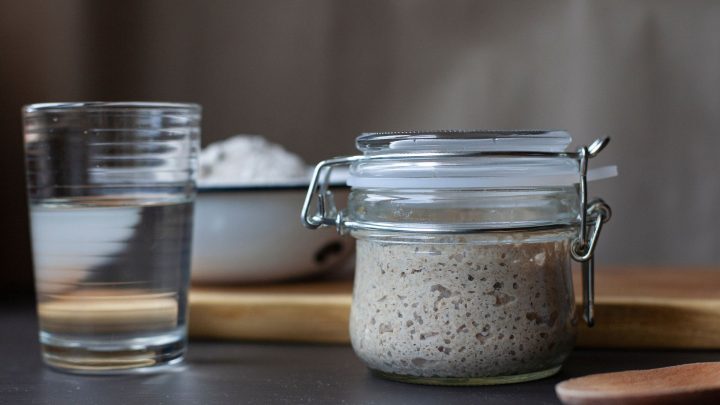
What if I Can’t Feed My Starter?
Everyone has busier days than others, and while feeding your starter isn’t necessarily hard, it can get in the way of day-to-day lives, i.e, travel, work, or leisure, and one should certainly not feel guilty about this! Fortunately, there is a simple solution to this problem, and that is to place your starter on hold until you’re ready for some sourdough baking. This only works for a mature sourdough starter, so if you’re dealing with a young starter, this might not work.
We already know that our sourdough starter can be stored on the kitchen counter for short periods, or in the refrigerator for a couple of weeks. But if you wanted to take a break from sourdough baking altogether, say for instance you need some months, or even years away from baking bread, then simply dry your sourdough starter.
Prepare Your Starter
Firstly, it’s important to feed your starter prior to drying it. If it has been stored in the fridge, then take it out, and feed it with equal parts unbleached all-purpose flour and lukewarm water. Let the starter rest, covered until it becomes very bubbly and healthy.
Spread It Out to Dry
Next, spread the starter onto two pieces of parchment paper. Make sure the parchment paper is placed on a baking sheet for easy transportation. The starter must be spread as thinly as possible. Use a spatula if you want to help spread it evenly.
Dry the Starter
Let the starter dry at room temperature, until it’s completely dry. This may take a day or even three depending on where you live. If you wish to speed up the process, however, you can easily dry your starter in the oven. But don’t turn your oven on, rather turn on the oven’s electric light, which will emanate a gentle heat. Turning your oven on, will create a very hot climate for your starter and might even kill it.
Once completely dry, the starter should easily peel off the parchment paper, and be brittle enough to snap between your fingers.
Break The Starter
Break the starter into small chips with your hands, or place it in a plastic bag, and hit it with something heavy. You can even run it through a food processor if you want to speed up the process.
Store It Airtight
Store the pieces of the starter in an airtight glass container. Add the date to the jar and label it so that you don’t accidentally throw it away. Keep the jar in a cool dark place, but not in the refrigerator.
How to Keep Your Starter Happy
The best way to prevent mold from appearing on your starter in the future is to figure out the root of the problem. If you’re storing your starter in the refrigerator, then make sure that it is placed in the coolest part of the fridge, and not in the door as this is the warmest part of the fridge.
Delicious Sourdough Recipes
Now that you have a healthy starter, here are some delicious sourdough recipes for you to try:
- Sourdough lemon cake
- Sourdough apple fritters
- Sourdough pretzels
- Sourdough breadsticks
- Sourdough chocolate chip cookies
How to Revive Sourdough Starter
And there you have it! That is how you successfully revive an inactive sourdough starter. If your sourdough starter tends to have liquid atop its surface, then take a look at how you can get rid of the sourdough starter hooch.
How to Revive an Inactive Sourdough Starter – FAQs
How do You Revive a Sourdough Starter in the Fridge?
To revive your starter, remove it from the fridge, and let it sit on the counter for a couple of hours until it has warmed. If the starter has some hooch pooling on the surface, simply stir it back into the starter.
How do I Know If I Ruined My Sourdough Starter?
The clear signs of a ruined sourdough starter is the presence of mold, bad odor, and pink/orange tints in your starter.
Can I Use Sourdough Starter After it is Deflated?
Yes. You should always bake even if your starter has deflated. You’ll still have a delicious loaf of bread, although it’ll lack oven spring.
How do I Refresh My Starter?
To refresh your starter, take 100g of starter (discard the rest) and add100g of water, and 100g of flour. Leave this to sit at room temperature for 8-12 hours before using and refrigerating.

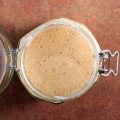
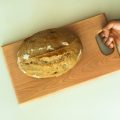
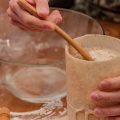

![Sourdough Starter Temperature [Beginner'S Guide] 8 Sourdough starter temperature [a beginner’s guide]](https://www.mydailysourdoughbread.com/wp-content/uploads/2023/01/blog-images-48-120x120.jpg)
